Discarding Yes and No
/ If you've ever been around teens or tweens, or were one yourself at some point, then you are familiar with 'discarding yes and no.' It is a look they give you that tells you they aren't listening, don't really care to be listening, and many not even be aware that you exist at all. Or as we use to say in Australia, 'I just couldn't be bothered.'
If you've ever been around teens or tweens, or were one yourself at some point, then you are familiar with 'discarding yes and no.' It is a look they give you that tells you they aren't listening, don't really care to be listening, and many not even be aware that you exist at all. Or as we use to say in Australia, 'I just couldn't be bothered.'So what do you think happens when I tell my adult students that I expect them to 'discard yes and no?' That's right! they all look at me quizzically, bring their faces forward a bit, sometimes tilting a little to one side, and nod 'yes' --Thereby demonstrating that they have no idea what I'm talking about.
If someone I know is walking alone in the distance and I call over to them to get their attention, as they turn they will look first, and then direct an 'I recognize you' face in my direction. With normal vision one can recognize this face from 100 yards away. And even if one has very poor vision, he or she will still display the 'I recognize you' face in return.
Comic Ellen Degeneres has a bit where she waves and shouts to get someone's attention and then realizes it isn't them. It's funny because she reveals how much socially stimulated pain this causes.
The effort it takes to communicate with our faces is usually completely unconscious. But I would suggest to my readers that normal social communication using the head and face requires enormous strength and torso tension. That's why teens and tweens sometimes just drop it. You never actually know if they are listening unless you quiz them afterwards, and even then they may decide not to participate. And the same is actually true for adults, they may be nodding 'yes' without hearing a single thing you've said. It could even happen with a loved one on Valentines day!
At about 6 months of age, babies can lift their head and they are capable of a lot of communicative facial expressions. However, their heads are so big relative to the rest of their bodies that they have to move their chest underneath their head in order hold it up. At some point they also learn to nod 'yes' and 'no,' but if you hang out with 5 year olds you'll see that, although they will give a very attentive 'I'm listening face,' they are often reluctant to nod 'yes' and 'no.' When they do stoop to this adult mode of communication they often exaggerate it with a whole body movement-- undulating with a slack jaw for 'yes,' and shaking horizontally for 'no.'
So. What's the point?
In martial arts and qigong, the head must be included in whole body movement for it to actually be whole body movement. If we are using our head for communication, it is very likely that we are exerting enormous torso tension in order to keep it in that state. As adults, stress is our default position in social situations.
I want to make a distinction here between structural integrity and whole body liquid mass. A person can be holding their head in an 'I'm ready to nod yes or no' position and still have structural integrity. As people age, the quality of the structural integrity tends to diminish, but it may still be there. However, it is not possible to have whole body liquid mass and hold ones head in such a stressful position at the same time.
I suspect that until a student figures out how to get their feet inside their dantian, inside their perception of space, this awareness of the head may be fleeting if it is possible to experience at all. When the whole body is inside the spacial mind it automatically includes the feet and head. It is by looking at the relationship between the torso and the head that, as a teacher, or a dude watching too many sub-standard 'masters' on Youtube, I can tell if a persons body is inside their mind--or not.
The head weighs a lot. Holding it in positions of dominance or submission is a major source of tension. Holding it in positions of dominance or submission is an obstacle to whole body power.

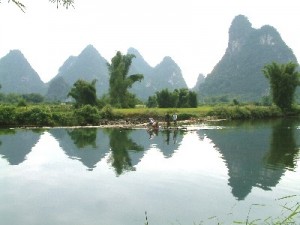 Secret teachings take a lot of abuse. Keeping secrets is widely denounced as a moral offense against modernity. But the truth is, the real secrets keep themselves. Secret teachings are concepts, revelations, and experiences which can not be taught. I can talk about them. I can show them. I can write about them. And to a certain extent, my actions might help transmit them. But it is just as likely that I'm confusing people and sending them off in the wrong direction. Secret teachings have to be discovered. And for such a discovery to happen there has to be a particular openness, a certain milieu, a series of experiences, and a perceptiveness about where to look and what not to do when the secret is found. The dark irony is that people are discovering these treasures all the time and then just burying them again, unaware.
Secret teachings take a lot of abuse. Keeping secrets is widely denounced as a moral offense against modernity. But the truth is, the real secrets keep themselves. Secret teachings are concepts, revelations, and experiences which can not be taught. I can talk about them. I can show them. I can write about them. And to a certain extent, my actions might help transmit them. But it is just as likely that I'm confusing people and sending them off in the wrong direction. Secret teachings have to be discovered. And for such a discovery to happen there has to be a particular openness, a certain milieu, a series of experiences, and a perceptiveness about where to look and what not to do when the secret is found. The dark irony is that people are discovering these treasures all the time and then just burying them again, unaware.


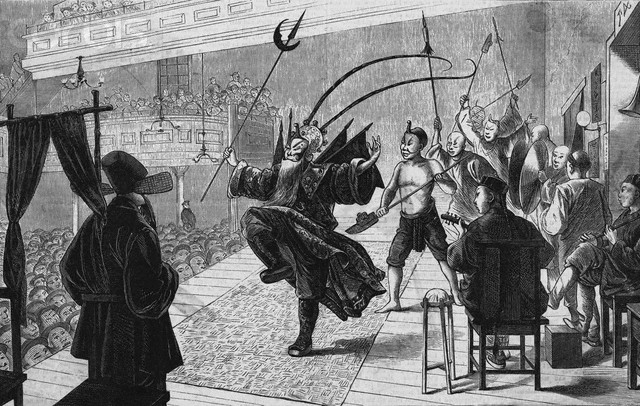
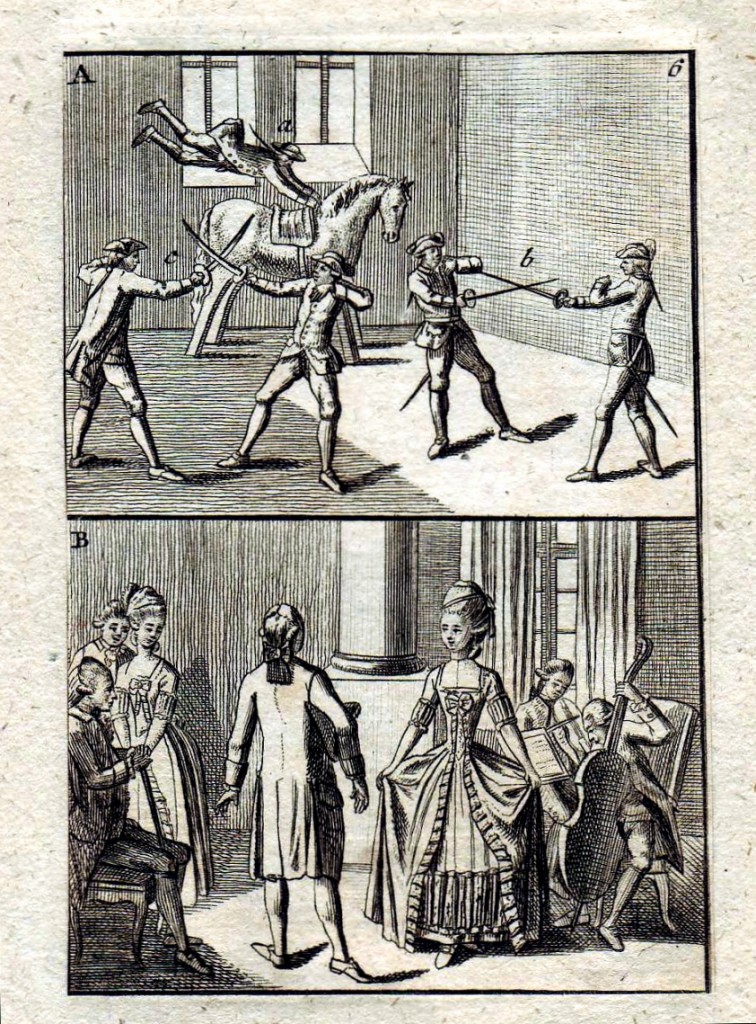 I don’t know that anyone was taking dictation at parties back then, but imagine the questions you would be asked by members of the aristocracy if you were a priest or a trader returning from a recent trip to China. “So what do the Chinese upper classes do for fun?” “What distinguishes an Chinese gentleman from the common rabble?” You would have, of course, told them about the Ming Dynasty “Scholar’s Cities,” that is, the theater districts just outside city walls that scholars young and old flocked too. “And what sorts of spectacles did they see?” “They saw actors and singers all of whom were trained from childhood in an extraordinary form of physical dance theater. A form of physical dance theater, you add, that demonstrated incredible feats of martial prowess. These ‘dancers’ were cast in history plays where they played great lords and ladies of the past, as well as warlords and youthful heros! Sometimes the fight scenes of these plays were the main attraction!”
I don’t know that anyone was taking dictation at parties back then, but imagine the questions you would be asked by members of the aristocracy if you were a priest or a trader returning from a recent trip to China. “So what do the Chinese upper classes do for fun?” “What distinguishes an Chinese gentleman from the common rabble?” You would have, of course, told them about the Ming Dynasty “Scholar’s Cities,” that is, the theater districts just outside city walls that scholars young and old flocked too. “And what sorts of spectacles did they see?” “They saw actors and singers all of whom were trained from childhood in an extraordinary form of physical dance theater. A form of physical dance theater, you add, that demonstrated incredible feats of martial prowess. These ‘dancers’ were cast in history plays where they played great lords and ladies of the past, as well as warlords and youthful heros! Sometimes the fight scenes of these plays were the main attraction!” The term xu is a key concept which ties together daoyin, the ritual body, trance, and all types of martial arts. The first definition my dictionary gives of xu is “empty” or “hollow” but this is misleading as the term
The term xu is a key concept which ties together daoyin, the ritual body, trance, and all types of martial arts. The first definition my dictionary gives of xu is “empty” or “hollow” but this is misleading as the term 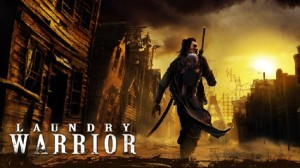 The Laundry Warrior is the correct and original name of a new movie which just came out under the bland title
The Laundry Warrior is the correct and original name of a new movie which just came out under the bland title  The fight choreography is good and the love interest part of the story is as good as it gets. Did I mention that the clothes are amazing? Oh yeah, the fights are mostly with swords, a little old-school Zatoichi technique and a little slow motion computer animation like the movie 300. The Koreans can all jump really high, especially out of water, it is almost like flying but they seem to come down hard. This style of fantasy fighting is cool and can really work but they really should consult me on the nature of momentum. The best fighters in the world, cats, do fight in the air! But cats must spiral and twist. Cats use rotational momentum combined with maximum internal power to fight. The films fighters rely too much on force generated from turning around a vertical center-line. Folks, if you are going to spend millions of dollars on an international project that employs people from Korea, Japan, the US, New Zealand, India and Australia--then I demand perfection!
The fight choreography is good and the love interest part of the story is as good as it gets. Did I mention that the clothes are amazing? Oh yeah, the fights are mostly with swords, a little old-school Zatoichi technique and a little slow motion computer animation like the movie 300. The Koreans can all jump really high, especially out of water, it is almost like flying but they seem to come down hard. This style of fantasy fighting is cool and can really work but they really should consult me on the nature of momentum. The best fighters in the world, cats, do fight in the air! But cats must spiral and twist. Cats use rotational momentum combined with maximum internal power to fight. The films fighters rely too much on force generated from turning around a vertical center-line. Folks, if you are going to spend millions of dollars on an international project that employs people from Korea, Japan, the US, New Zealand, India and Australia--then I demand perfection!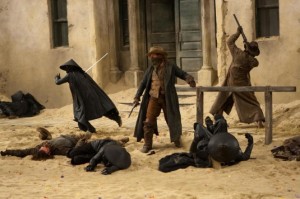 Now to the important stuff. Every little kid knows that the outfit, the kung fu or karate uniform, is a key component of the art. I often hear parents tell me, "My son really wanted to do kungfu and begged me for a long time, but when I finally signed him up and he started taking classes I realized what he really wanted was the outfit not the hard work!" Kids get shamed about this pretty early. They are told that the uniform is just a vain symbol and that what really matters is doing forms. Later they shame you about that and tell you that it's not the forms it's the applications and techniques that matter. And if you make it that far you are likely to get shamed about those too, sparring and competitions are what really matter! And if you make it through all that it's all about philosophy and health. It took me many years to realize that the observations of little kids were correct all along. The power is in the outfit!
Now to the important stuff. Every little kid knows that the outfit, the kung fu or karate uniform, is a key component of the art. I often hear parents tell me, "My son really wanted to do kungfu and begged me for a long time, but when I finally signed him up and he started taking classes I realized what he really wanted was the outfit not the hard work!" Kids get shamed about this pretty early. They are told that the uniform is just a vain symbol and that what really matters is doing forms. Later they shame you about that and tell you that it's not the forms it's the applications and techniques that matter. And if you make it that far you are likely to get shamed about those too, sparring and competitions are what really matter! And if you make it through all that it's all about philosophy and health. It took me many years to realize that the observations of little kids were correct all along. The power is in the outfit! Adults think they are more savvy. They are less likely to be 'fooled' by an ethnic costume. But growing a beard doubled my credibility teaching at the college level. Imagine what a couple of inches in eyebrow length could do? What you wear and how you wear it has a profound effect on teaching. Clothing conveys ones degree of seriousness, whimsy, toughness, or irony better than anything which can be said or written on a white board.
Adults think they are more savvy. They are less likely to be 'fooled' by an ethnic costume. But growing a beard doubled my credibility teaching at the college level. Imagine what a couple of inches in eyebrow length could do? What you wear and how you wear it has a profound effect on teaching. Clothing conveys ones degree of seriousness, whimsy, toughness, or irony better than anything which can be said or written on a white board.